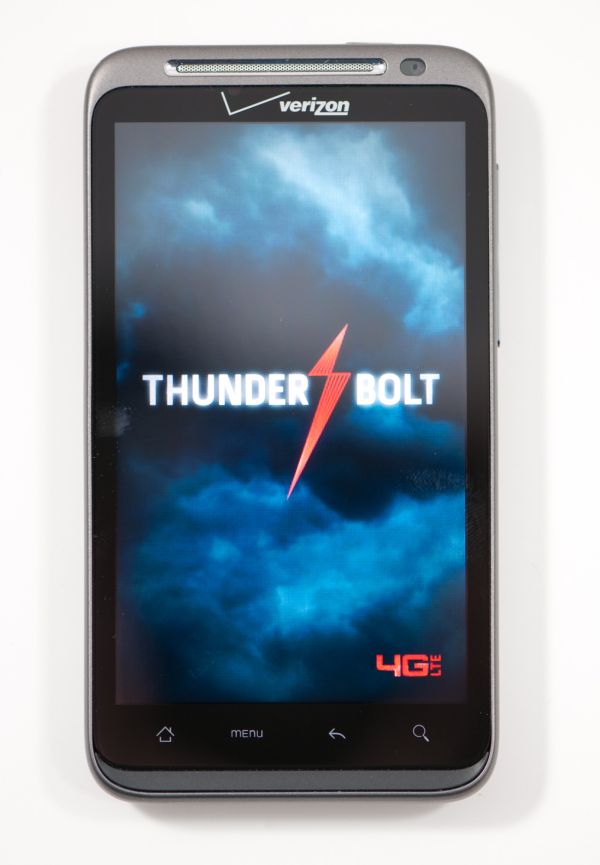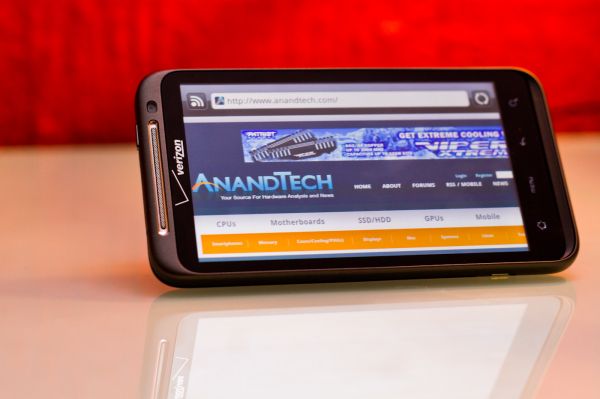HTC Thunderbolt Review: The First Verizon 4G LTE Smartphone
by Brian Klug on April 27, 2011 12:12 AM EST- Posted in
- Smartphones
- HTC
- Verizon
- LTE
- 4G
- Android
- HTC Thunderbolt
- Mobile
- MDM9600
- MSM8655
Conclusion
The Thunderbolt reminds me of the EVO, and otherwise shares design language with all of HTC’s 4.3” form factor smartphones. The comparisons are so completely obvious that it’s almost pointless stating all of them. It’s a phone packed with latest and greatest cellular connectivity that actually does a very good job at disguising the number of design challenges doing so poses. LTE is easily an order of magnitude faster than EVDO, and if you're as obsessed with cellular network throughput as I am, the added thickness and reduced battery life are absolutely worth it.
I’ve talked a lot about thickness and weight, but at the end of the day the Thunderbolt is entirely pocketable and feels great in the hand. Despite not being metal and unibody like the Desire HD, the phone feels sturdy and build quality isn’t going to disappoint. It’s almost unfair to make size and weight comparisons against devices that are primarily built around one transceiver and a SoC.
That said, there’s no getting around issues such as battery life and the fact that though the Thunderbolt is the current latest and greatest, it still lacks dual core and a qHD screen. Those two features are going to be must-have in the next set of refreshes from HTC, and as a result makes the Thunderbolt almost feel a bit delayed. Battery life can be doubled by using the double capacity official battery, but again at the expense of adding more mass and thickness to an already beefy handset.

The HTC Thunderbolt in front of a Verizon 4G LTE eNodeB
The Thunderbolt’s cellular architecture is impressive, and its status as the first smartphone on Verizon (or CDMA2000 to the best of my knowledge) that can offer simultaneous voice and data in both 3G and 4G network conditions is a huge plus even if you aren’t in a 4G LTE market. It’s very surprising to me that Verizon has neglected to pick up on and aggressively market that selling point, considering AT&T's repeated jabbing. It’s a special extra that will likely continue to distinguish the Thunderbolt from a growing lineup of 4G LTE enabled smartphones set to arrive on Verizon this year. It's likewise surprising that the Thunderbolt isn't a "Droid" level phone, and considering the amount of unique things the Thunderbolt brings to the table, the other 4G LTE smartphones will have their work cut out for them stacking up. 4G LTE works perfectly on the handset, and is fast enough that I believe we’re back to page loading being SoC-bound rather than network-bound.












71 Comments
View All Comments
HangFire - Wednesday, April 27, 2011 - link
I credit this to Angry Birds. The bigger the tablet, the better the experience.MilwaukeeMike - Wednesday, April 27, 2011 - link
Well... it comes with a kickstand, clearly they want us to watch movies on them, which means they're not going to get any smaller. Have you ever had one though? It's not that bad. I have a double sized battery on my EVO and the extra width actually makes it easier to take out of my pocket (The ridge by the kickstand makes a little 'handle') and easier to hold sideways.MilwaukeeMike - Wednesday, April 27, 2011 - link
Oh... and a thicker phone means it's more likely in contact with your leg (guys) if in your pocket and increases the chance that you'll feel it when on vibrate.HangFire - Wednesday, April 27, 2011 - link
Brian, great in-depth review.The original Tbolt specs had 8GB of NAND Flash, but mine only reads 4. I've heard a rumor the that half was locked out to help deal with the battery issue, and another rumor that it might be "unlocked" some day. Do you have any info?
Also, some mention should be made of the awful Blockbuster app that comes pre-installed, with permissions to spy on everything, running processes that constantly use data, and cannot be uninstalled short of rooting. HTC and Verizon should be made to understand that such shovelware/crapware is totally unacceptable.
I found the 5MP T-Mobile G2 camera much better indoors/low-light than my Tbolt. Alas, T-Mobile has poor data in my area so I moved over to Verizon and the Tbolt. I think the pointless increase in Megapixels is the cause. I'd like to see better pictures, not better specs.
Brian Klug - Wednesday, April 27, 2011 - link
Interesting, I went with the HTC specifications which list 8 GB, but see what you mean about 4 GB now on this Thunderbolt. Very curious. I don't think the reason could be battery usage since it's nonvolatile, though I've heard lots of discussion about devices with 1 GB+ of RAM using more battery. I'll ask some questions and find out.The funny part about the crapware on the Thunderbolt is that it's actually far less than I see on the Inspire 4G. I haven't seen the Blockbuster app be persistent (though that could be because I haven't launched it), but otherwise yes you're completely right about the preload situation.
-Brian
sooper_anandtech12 - Wednesday, April 27, 2011 - link
Nice to see that the 3.7" 854x480 display on the Droid and Droid 2 still rockin' it as one of THE best displays in the mobile space. As for the push towards qHD displays. To be honest, I would like Motorola and the rest of them to hold off on these qHD displays. They all employ PenTile pixel substructures which effectively means there are less pixels than advertised. Looking at an Atrix display compared to my Droid's display and it's clear the Atrix should have been called Atrocious. The pixelation around widgets and on wallpapers was unacceptable. I haven't seen pixelation like that since AMOLED. Why release qHD PenTile LCDs when Samsung recently admitted PenTile stinks and is going with a normal RGB set up with S-AMOLED+? I'd rather see a nice IPS display like in the LG G2X, running at the antiquated 800x480 than a qHD display running 30% less pixels than the 960x540 that's advertised.mlosee222 - Wednesday, April 27, 2011 - link
Confirmed by threads at xda developers and other sources:http://www.engadget.com/2011/04/27/verizons-lte-ne...
Maybe its just the verizon commercials, but what has me sold is the network. I could honestly care less about the phone compared to the speeds LTE offers. Voice is a secondary consideration to data throughput for me. I would buy the thunderbolt for the network alone.
With that being said, I sincerely hope verizon's LTE isn't as overloaded and useless as T-Mobile's "3G" network is.
hans007 - Wednesday, April 27, 2011 - link
i agree. as someone who just left t-mobile for verizon, their network is terrible now at least for data. their voice isn't really spectacular either.in the bay area, their 3G coverage was really spotty.
and i am also in los angeles a lot and t-mobile has a ton of dead zones. i can't believe they advertise it as 4G as it felt slower than 3G on verizon.
Brian Klug - Wednesday, April 27, 2011 - link
It's a bitter irony really, of course the day after I post everything, eHRPD goes down and takes 4G LTE and 3G EVDO (on eHRPD) with it.If you go into EPST (##778#) and enter MSL (000000), you can change the modem setting under Rev.A to use just HRPD instead of eHRPD. That way, you're anchored through the old 3G data network instead of the common anchor point for EVDO and LTE that appears to be having problems right now.
I've been having sporadic EVDO (eHRPD) connectivity all day with dips to 1x. Unfortunate, but things like this will gradually get better in time.
-Brian
synaesthetic - Thursday, April 28, 2011 - link
Really depends on where you live, and plus you also get what you pay for. T-Mobile is considerably cheaper than Verizon.For slightly less service (assuming I do not buy an LTE device), Verizon charges me $30 more than T-Mobile does. From $65 to $95 for almost exactly the same service (though I lose 50 minutes of anytime minutes on Verizon).
Considering the uncertain future of T-Mobile US, I am considering Verizon as an option, but to me the device--and more specifically, the ROM--is the most important thing as long as my network speeds are decent enough.
For the record, my T-Mobile HSPA+ in downtown Berkeley is excellent, usually 6-7Mbps down and 2-3Mbps up. Absolutely sufficient for my purposes. At home, yeah, in the 'burbs my data speed kind of bites... but I have wifi and much faster wired broadband, why would I bother with using my data plan at home? :D